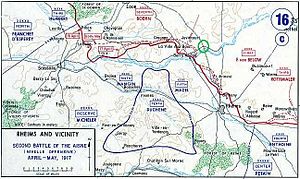Second Battle of the Aisne
| Second Battle of the Aisne | |||||||
|---|---|---|---|---|---|---|---|
| Part of the Western Front of World War I | |||||||
 Chemin des Dames and Champagne, 1917 |
|||||||
|
|||||||
| Belligerents | |||||||
|
|
|
||||||
| Commanders and leaders | |||||||
|
Robert Nivelle Franchet d'Espèrey Alfred Micheler Philippe Pétain Charles Mangin François Anthoine Olivier Mazel Denis Duchêne Georges Humbert |
Erich Ludendorff Crown Prince Wilhelm Max von Boehn Fritz von Below Karl von Einem |
||||||
| Strength | |||||||
| 53 divisions | 38 divisions | ||||||
| Casualties and losses | |||||||
| c. 187,000 | c. 163,000 | ||||||
The Second Battle of the Aisne (French: Bataille du Chemin des Dames or Seconde bataille de l'Aisne, 16 April – mid-May 1917) was the main part of the Nivelle Offensive, a Franco-British attempt to inflict a decisive defeat on the German armies in France. The strategy was to conduct sequenced offensives from north to south, by the British Expeditionary Force (BEF) and several French army groups. General Robert Nivelle planned the offensive in December 1916, after he replaced Joseph Joffre as Commander-in-Chief of the French Army. The objective of the attack on the Aisne was to capture the prominent 80 kilometres (50 mi) long, east–west ridge of the Chemin des Dames, 110 kilometres (68 mi) north-east of Paris and then attack northwards to capture the city of Laon. When the French armies met the British advancing from the Arras front, the Germans would be pursued towards Belgium and the German frontier. The offensive began on 9 April, when the British attacked at the Battle of Arras. On 16 April, the Groupe d'armées de Reserve (GAR) attacked the Chemin des Dames and the next day, the Fourth Army of Groupe d'armées de Centre (GAC), near Reims to the south-east, began the Battle of the Hills.
The Chemin des Dames ridge had been quarried for stone for centuries, leaving a warren of caves and tunnels which were used as shelters by German troops to escape the French bombardment. The offensive met massed German machine-gun and artillery fire, which inflicted many casualties and repulsed the French infantry at many points. The French still achieved some substantial tactical successes and took c. 29,000 prisoners in their attacks on the Chemin des Dames and in Champagne but failed to achieve their strategic objective of a decisive defeat over the Germans. The failure had a traumatic effect on the morale of the French army and many divisions mutinied. Nivelle was superseded by General Philippe Pétain, who adopted a strategy of "healing and defence"; on 19 May Pétain issued Directive No 1 for limited offensives, intended to resume the wearing-out of the German Army while conserving French infantry. The new French strategy was not one of passive defence. In June and July the Fourth, Sixth and Tenth Armies managed to conduct several limited attacks and the First Army was sent to Flanders to participate in the Third Battle of Ypres.
...
Wikipedia
